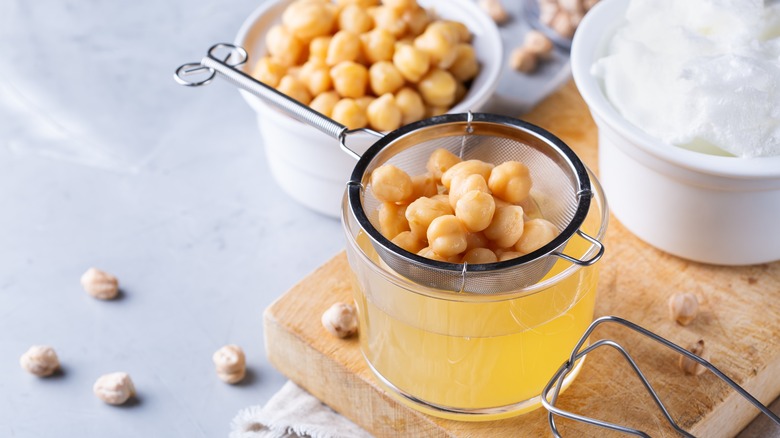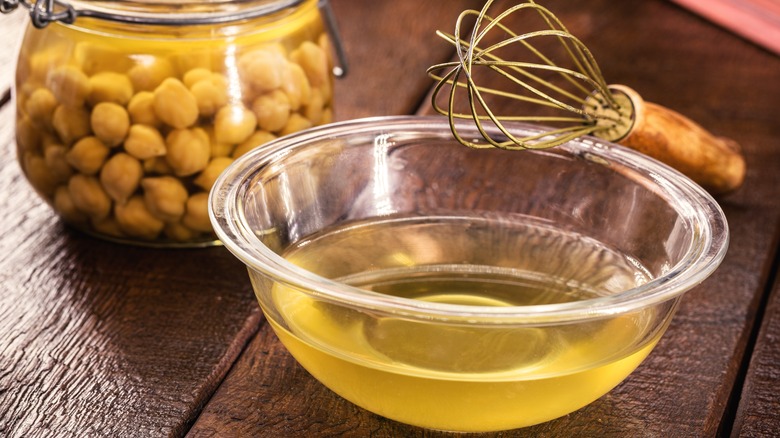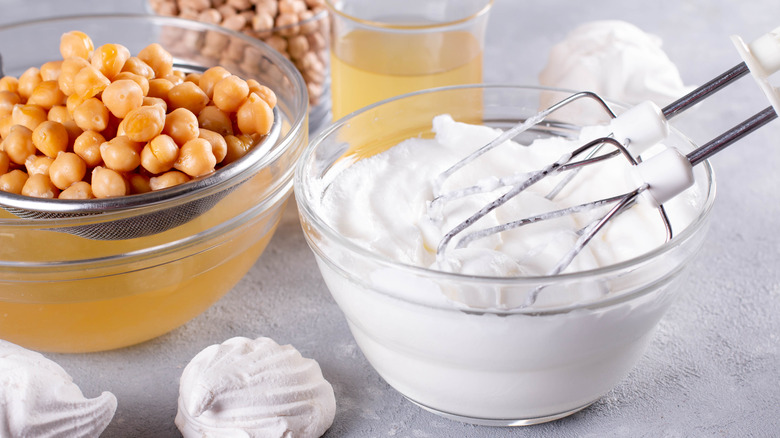What Is Aquafaba And How Should You Get It?
Aquafaba. It's a strange sounding word, but it's really fun to say. Even if you've never heard the word before, you probably have some in your pantry right now. And you can use it to make marshmallows and meringues and even mayonnaise. So, how was this miracle product discovered? How does it work? And how should you get it?
As it turns out, aquafaba was discovered by an engineer who was looking for a vegan replacement for egg whites. You see, vegans had been trying to find good egg substitutes for decades. They'd use everything from bananas to flax seed to chia seeds and even tofu, but finding a good foam replacement proved difficult. Eggs have unusual properties that let them work in so many recipes.
Eggs can bind ingredients together, they provide leavening, the yolks can emulsify and thicken sauces, and whole eggs add moisture as well as stabilize the structure of baked goods, per Sauder's Eggs. And egg whites have a special ability — they can make fluffy, light foams. So the main goal of aquafaba researchers was to find an egg white substitute to replace foam.
The science of aquafaba
Aquafaba literally means "bean water," and not just any bean will do. While bean water can come from cooking any legume, experimenters found that the liquid canned chickpeas are packed in is the best aquafaba, with the proper combination and proportion of starches and proteins, according to America's Test Kitchen. Chickpeas also have a compound called saponin, which acts like soap, according to McGill University. Although that may sounds unappetizing, it helps stabilize the foam. The chickpea has another property going for it, too. It's the most mild-flavored, so your meringues won't taste "beany."
Who discovered this miracle vegan egg white substitute? There were many experiments over the years, but in 2015, an engineer hit on the right ingredient. That engineer, Goose Wohlt, built on the work of Frenchman Joël Roessel, who was working with vegetable foams, explains Aquafaba.com. And just why does this liquid form such nice foams? When the right mixture of protein, water, and starch is whipped, the proteins "denature," which is just a fancy word for unfold, per Love Food Love Science. The unfolded proteins form a web that traps air. Voila: foam.
But as it turns out, aquafaba foam is pretty unstable. Within about 20 minutes, America's Test Kitchen found that the foam reverts to liquid. So they added cream of tartar, the same white powder you add to egg white foams to stabilize them. That did the trick — lowering the pH, or acid level, of the aquafaba is key.
How to make and use aquafaba
There are several ways to get your hands on some aquafaba. You can just shake a can of chickpeas, open the can, and drain the peas into a sieve placed over a bowl. You can also make homemade aquafaba, per Forks Over Knives. That method takes more time, obviously, but it can be satisfying for people who like to cook dried beans from scratch. You can also buy dried aquafaba, according to Vor, and use it according to the package instructions.
Once you have a supply of aquafaba on hand, you can use it in recipes. You can try a rich aquafaba chocolate mousse recipe or make smooth and creamy vegan mayo. Try using aquafaba in a luscious vegan lemon meringue pie, suggests Nora Cooks, or make crisp, tender meringue cookies, per It Doesn't Taste Like Chicken.
You can even use it to make vegan pancakes, suggests The Pancake Princess. You may never go back to egg whites.


